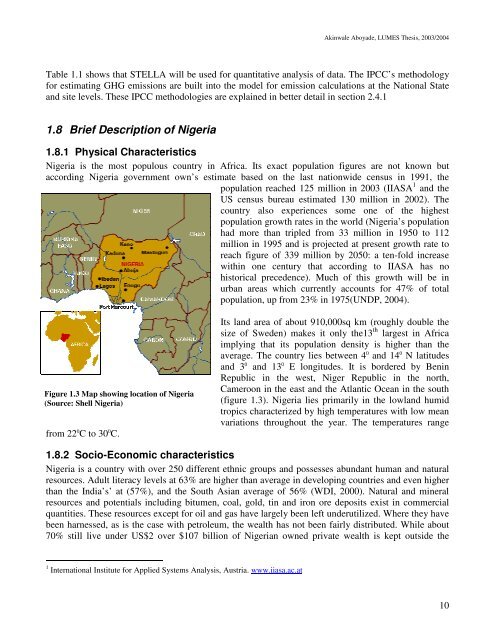Wale Aboyade's thesis - lumes
Wale Aboyade's thesis - lumes
Wale Aboyade's thesis - lumes
Create successful ePaper yourself
Turn your PDF publications into a flip-book with our unique Google optimized e-Paper software.
Akinwale Aboyade, LUMES Thesis, 2003/2004<br />
Table 1.1 shows that STELLA will be used for quantitative analysis of data. The IPCC’s methodology<br />
for estimating GHG emissions are built into the model for emission calculations at the National State<br />
and site levels. These IPCC methodologies are explained in better detail in section 2.4.1<br />
1.8 Brief Description of Nigeria<br />
1.8.1 Physical Characteristics<br />
Nigeria is the most populous country in Africa. Its exact population figures are not known but<br />
according Nigeria government own’s estimate based on the last nationwide census in 1991, the<br />
population reached 125 million in 2003 (IIASA 1 and the<br />
US census bureau estimated 130 million in 2002). The<br />
country also experiences some one of the highest<br />
population growth rates in the world (Nigeria’s population<br />
had more than tripled from 33 million in 1950 to 112<br />
million in 1995 and is projected at present growth rate to<br />
reach figure of 339 million by 2050: a ten-fold increase<br />
within one century that according to IIASA has no<br />
historical precedence). Much of this growth will be in<br />
urban areas which currently accounts for 47% of total<br />
population, up from 23% in 1975(UNDP, 2004).<br />
Figure 1.3 Map showing location of Nigeria<br />
(Source: Shell Nigeria)<br />
from 22 0 C to 30 0 C.<br />
Its land area of about 910,000sq km (roughly double the<br />
size of Sweden) makes it only the13 th largest in Africa<br />
implying that its population density is higher than the<br />
average. The country lies between 4 0 and 14 0 N latitudes<br />
and 3 0 and 13 0 E longitudes. It is bordered by Benin<br />
Republic in the west, Niger Republic in the north,<br />
Cameroon in the east and the Atlantic Ocean in the south<br />
(figure 1.3). Nigeria lies primarily in the lowland humid<br />
tropics characterized by high temperatures with low mean<br />
variations throughout the year. The temperatures range<br />
1.8.2 Socio-Economic characteristics<br />
Nigeria is a country with over 250 different ethnic groups and possesses abundant human and natural<br />
resources. Adult literacy levels at 63% are higher than average in developing countries and even higher<br />
than the India’s’ at (57%), and the South Asian average of 56% (WDI, 2000). Natural and mineral<br />
resources and potentials including bitumen, coal, gold, tin and iron ore deposits exist in commercial<br />
quantities. These resources except for oil and gas have largely been left underutilized. Where they have<br />
been harnessed, as is the case with petroleum, the wealth has not been fairly distributed. While about<br />
70% still live under US$2 over $107 billion of Nigerian owned private wealth is kept outside the<br />
1 International Institute for Applied Systems Analysis, Austria. www.iiasa.ac.at<br />
10

















